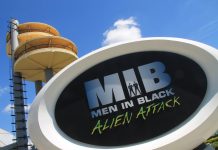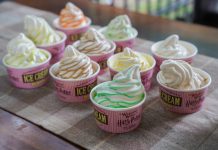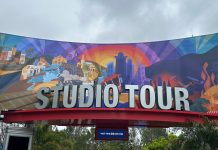A profoundly influential innovator in the themed entertainment industry, Dave Cobb has been involved in the development of Universal Theme Parks since his days as a Studio Tour guide at Universal Studios Hollywood. Now in the role of Vice President of Creative Development at Thinkwell Group, Dave reflects on his past as a Studio Tour guide, Universal Studios Hollywood’s then transition into a full fledged theme park, the development of Terminator 2:3D and Men in Black and more.

Mr. Cobb, thank you for joining us. In an interview with Behind the Themes you mention that you initially got your start with Universal as a Studio Tour guide back in 1987. Could you describe your interactions with Universal Studios Hollywood during this period, and were there any significant challenges associated with traversing Universal’s diverse backlot with guests?

Working as a guide was one of the best jobs ever. I got to explore the studio every day, got to entertain people, and made tons of lifelong friends. Working in any park obviously has its challenges – long hours, hot summers, cranky guests – but I wouldn’t trade my days as a guide for anything.
They really laid the basis for my understanding of how a major park operates, and a daily perspective on the guest experience. I recommend that anyone who wants to work in the attraction design industry consider working in a park or similar large-scale entertainment venue – be it a museum, aquarium, zoo or even a theatrical venue – if only to understand the basics of how people uses places to be entertained. It’s an education that a design school can’t give you.

On that same note, how did the Studio Tour operate in conjunction with the theme park? Was Universal still primarily a Studio Tour with a few entertainment options on the side, or had it – by that time – evolved into a well-rounded experience with attractions comparable with other theme parks?
I got to work there at a very exciting time when the tour was expanding – it actually changed names from “Universal Studios Tour” to Universal Studios Hollywood” while I was working there, indicating a change from just a backlot tour to a more theme-park-like operation with multiple attractions. They’d always had the “top deck” entertainment center with shows, but those shows were getting bigger (“Miami Vice” was opened while I was there) and the tour animations were getting bigger (“Earthquake” opened while I was there, too).
So I really got to experience, from the inside out, how a major operation deals with expansion and bigger development. I took a tour of the model for Universal Studios Florida in 1989, which really indicated to me how big Universal was starting to think. It was very inspiring, and eventually led me to the career I have today.
Earthquake – The Big One opened a year after you got your start at Universal in 1988. What was the impact of the new tour animation on the park, and what were your impressions of Universal’s (then) latest attraction?
Like any major attraction, it had some opening-season hiccups – I remember long lines of trams waiting to go inside the show building on opening day, with really long waits. I never got tired of seeing it, though, especially watching guests react to it – they’d never seen anything like it. My favorite thing to point out to them as a guide was actually after the show was done, that it only took 25 seconds to completely reset the whole thing. It’s pretty unprecedented, and I think attractions like Earthquake show how Universal has always been very unique with their approach to epic, large-scale immersion.

Moving to the theme park, Back to the Future: The Ride – one could argue – began Universal Studios Hollywood’s transformation from a studio with a tour into a full-fledged theme park destination. What was it like to work with the Back to the Future franchise, and what was the process behind porting an existing attraction from one park (in this case, Universal Studios Florida) to another? Were there compromises or changes that needed to be addressed in Hollywood’s installation?
I actually posted a really long blog entry about working on Back to the Future, back in 2010 during the movie’s 25th anniversary. I was really lucky to be in a time and place to be able to get the opportunity to work on such a blockbuster attraction – it had been so innovative and such a success at Universal Studios Florida, so there was a lot of enthusiasm about bringing it west. The biggest challenge to the Hollywood version was the mountainside site – the structural engineering of the building was amazing, given that it’s not on flat ground and has so much dynamic load occurring inside the building from 24 motion bases at once. Fun fact: BTTF was originally intended to be built atop the parking structure, next to “Streets of the World”, where “T2/3D” ended up, now “Despicable Me: Minion Mayhem” – so that site got a simulator ride after all!

What was the experience like when Back to the Future: The Ride finally opened in 1993, and how did Universal Studios Hollywood handle the (we’re guessing!) influx of guests?
Very carefully! I think BTTF benefited from the fact that USH had already opened one “stand-alone” ride attraction outside the tram tour with E.T. a few years earlier. The crowds for BTTF were huge, of course, but it’s a very high-capacity attraction and had, at the time, the biggest queue in the park, so it sucked up a lot of people. It had to, because that park simply doesn’t have a lot of land, and at the time, didn’t have a lot of instantaneous attraction capacity. But I have fond memories of opening season of BTTF because of the sheer enthusiasm of the ops staff — they were devoted to the ride in a way I haven’t often seen with ride ops, and totally got “in character” as employees of the Institute of Future Technology.

Following your stint with Universal, you later moved to Landmark Entertainment (known for such attractions as Jurassic Park: The Ride and Terminator 2: 3D) in the mid 1990s. What were some notable experiences during your tenure with the firm, and did your creative perspective evolve with each successive project?
Landmark was a lot of fun – I got to work with a lot of really talented designers, many of which I consider my mentors, like Adam Bezark and Ty Granaroli. Working there gave me my first experience with working internationally, and I got to travel all over the world at a pretty young age, professionally (in my mid-20s). Traveling was probably the most notable evolution for me — seeing other cities, countries and cultures really expanded my worldview, affecting me professionally and personally, making me really strive to be a citizen of the world. Landmark was also very writer/director-driven (much like Universal was), and was a very small and agile organization, giving me an incredible amount of creative input on lots of projects very early in my career; so, I have Landmark’s Gary Goddard and Tony Christopher to thank for that early “trial by fire” education.
“Traveling was probably the most notable evolution for me — seeing other cities, countries and cultures really expanded my worldview, affecting me professionally and personally, making me really strive to be a citizen of the world.”
I worked on some amazing projects, like T2/3D & Jurassic Park at Universal as you mentioned, Star Trek & Caesars Magical Empire in Las Vegas, and even some unproduced, early blue-sky concepts for Marvel Super Hero Island at Universal’s Islands of Adventure. One of my favorite projects was the “M&M’s Academy”, a small retail attraction at M&M’s World in Las Vegas. It was a walkthrough attraction based on the idea that the M’s have to “earn their letter” at the Academy in order to become a full-fledged M&M – it had a bunch of interactive effects, a spinning vortex tunnel, lots of neat little touches, giving you the feel that you were “becoming an M&M”. At the end of the walkthrough there was 4D theater show with CG animation from the legendary Will Vinton productions, called “I Left My M in Vegas” – where Red & Yellow mistakenly gamble away their hard-earned “M” and go on a wacky multi-dimensional journey – to the mysterious place where all the “lost stuff” goes, like keys, socks, and TV remotes – to retrieve it. Tonally, we borrowed heavily from “Cranium Command” at Epcot, which will always have a place in my heart as one of the best things that Disney has ever done – so it became a sort of spiritual cousin to this M&M’s attraction as we were developing it. It was my first concept-to-opening project, very small and charming. I don’t think the walkthrough is there anymore, but I believe the movie still plays daily!

Subsequently, after your time with Landmark, you moved briefly back to Universal Creative as creative director for Men in Black: Alien Attack at Universal Studios Florida. Were there any challenges associated with the development process (specifically the pitch to Universal), and did Universal have any specific requests concerning the ride?
Wow, that’s a whole article unto itself! If I had to distill it down to something simple, the biggest challenges with MIB were twofold: first, that the innate guest expectation was to see a very wide variety of aliens, which led to a very long visual development process for all of the targets and characters; and second, that we actually didn’t have a very long schedule. MIB went from blue-sky, nothing-on-paper concept to opening day in something like 28 months, which is really, really short. The reasons for this compressed schedule are complicated, but suffice it to say, Universal wanted a major attraction to open at the Studios park the year after IOA opened, so we worked very, very fast and had a stupendously talented team. If you’re interested, I did a pretty extensive Q&A on MIB over at Theme Park Insider — be sure to read down into the comments, as I answered a bunch more questions there too!), and there’s a two-parter about MIB on the Season Pass Podcast (Part 1 & Part 2)

Finally, do you have any thoughts on Universal Studios Hollywood’s five-year transformation plan, and the addition of Springfield, Fast and Furious: Supercharged and the Wizarding World of Harry Potter? What are your thoughts about the park in its current state?
While I have really fond memories of the “old” Universal where I worked as a guide, the changes they’ve been making to the park are really, really inspiring. There’s some incredibly smart design there, happening on an unbelievably challenging site, reinventing what an urban park experience is about. I adore Super Silly Fun Land, I love the new Springfield (even more than the USF version!) and am really excited to see what new tricks and techniques Fast & Furious uses. My excitement for Potter goes without saying; having Butterbeer available this close to home doesn’t bode well for my addiction!

Special thanks to Dave Cobb for taking the time to participate in this written interview. You may follow Dave on Twitter at @DaveCobb and Thinkwell Group on their official website.









